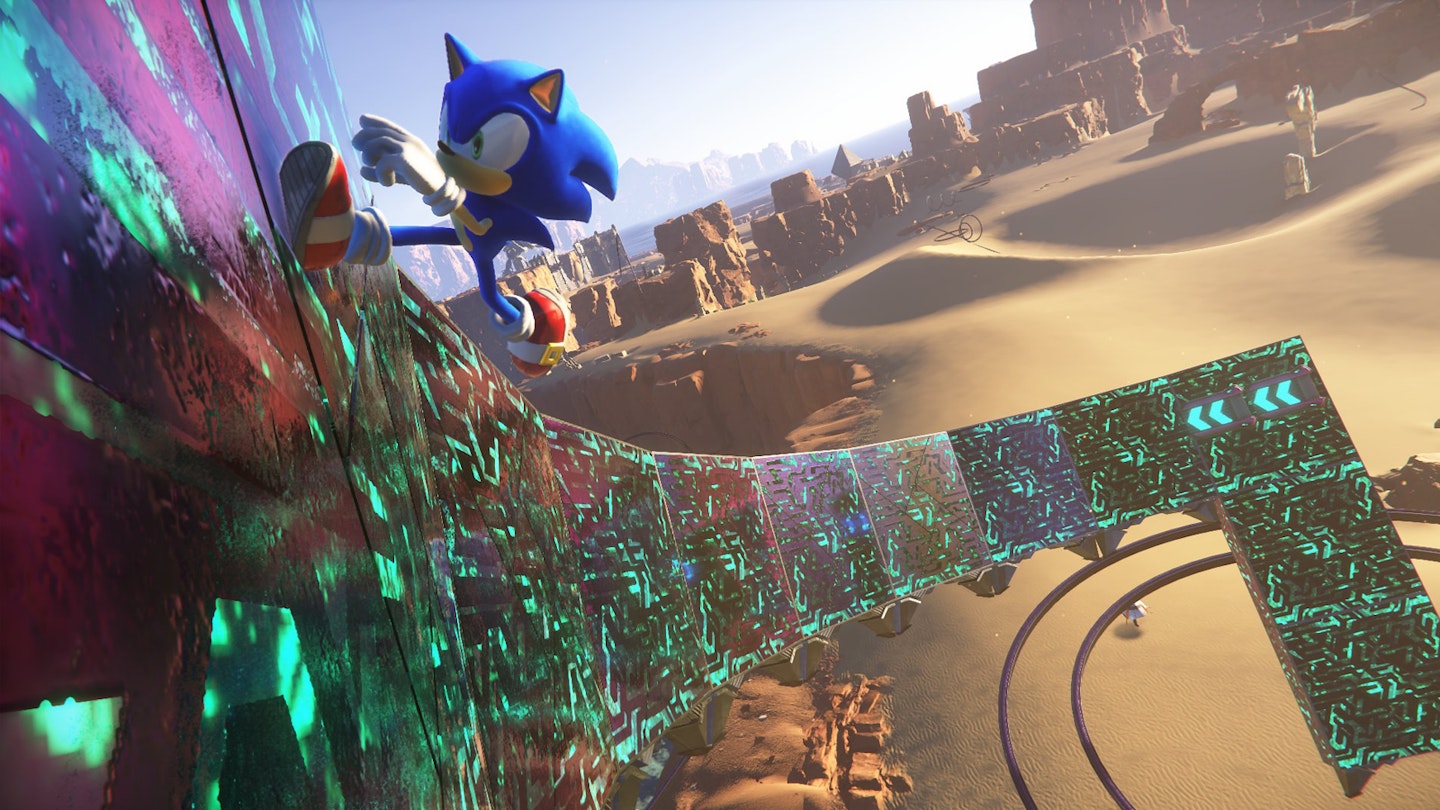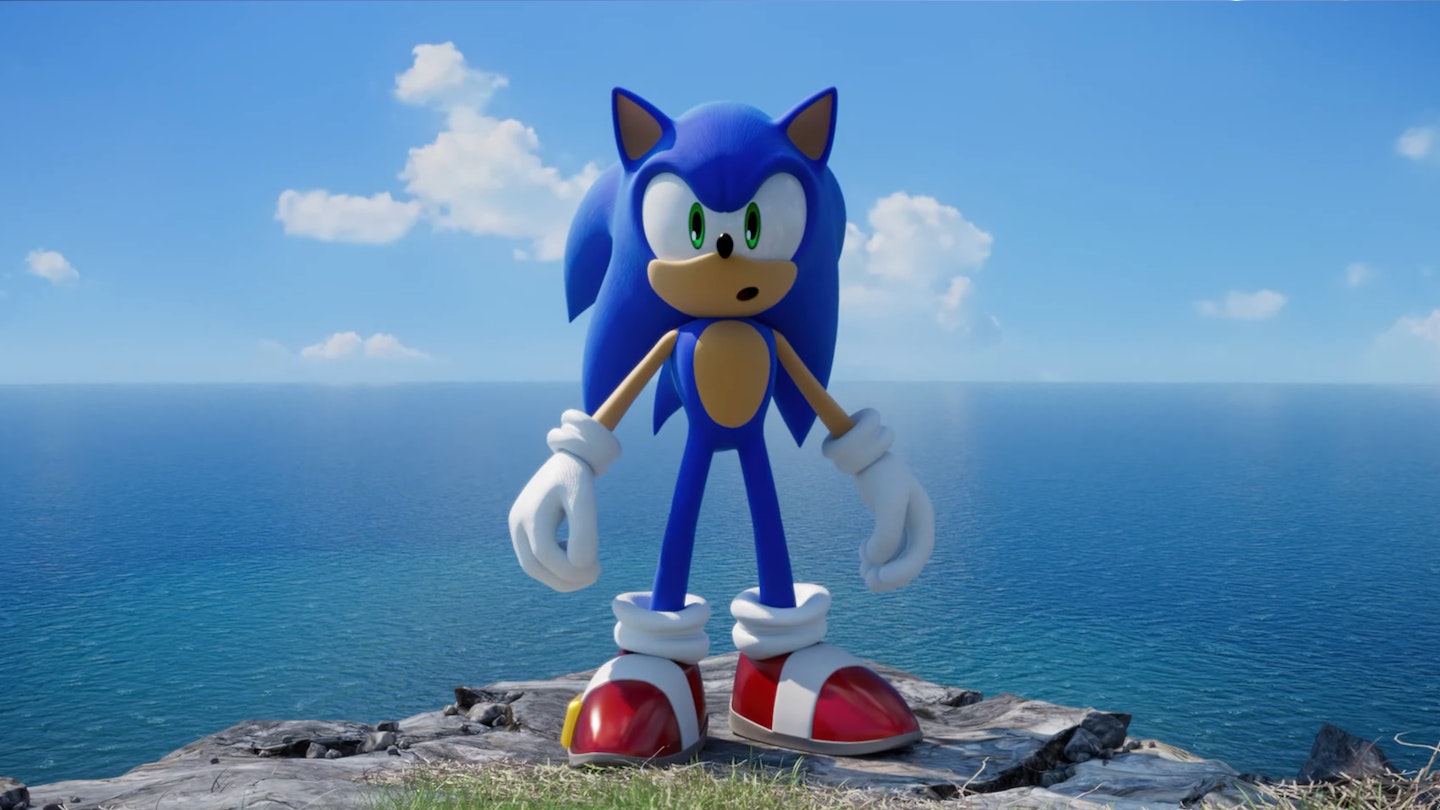Platforms: PS5, PS4, Xbox Series X, Xbox One, Nintendo Switch
From the moment Sonic Frontier’s first teaser trailers offered a glimpse at its newfound open world approach, Sega’s latest outing for the Blue Blur struggled to outrun comparisons to Nintendo’s seminal The Legend Of Zelda: Breath Of The Wild. With the full game racing into view, the influence that Link’s last grand adventure has had on Sonic’s newest one is undeniable.
In some cases, it’s merely visual overlap, with the architecture and landscapes — filled with vast open plains, vine-strewn ruins, and buried hints of lost, ancient cultures — making the similarities to blighted Hyrule unavoidable. In other areas though, there are gameplay and progression mechanics that seem lifted straight from Link’s most recent foray (most notably a straight lift of the latter’s random ‘Blood Moon’ event that resurrects all defeated enemies), jammed somewhat awkwardly into Sonic’s mold of speedy platforming. To developer Sonic Team’s credit, the unlikely mix succeeds slightly more often than it fails, but this isn’t the resurgent adventure for the hyper-speed hedgehog that fans may have hoped for.

Frontiers’ greatest failure is perhaps being overly cautious, unsure of just how much it wants to revamp the series. For one thing, it’s not a true open world game, at least not on the scale of its chief influence. The story, penned by long-time Sonic writer Ian Flynn, finds Sonic and pals Tails, Amy, and Knuckles drawn to the Starfall Islands by the ever-unpredictable Chaos Emeralds, with each of the five islands offering a still large, yet self-contained, open field to explore. The separation loosely fits the story, but not in a way that couldn’t have been written around, and in practice, seems largely in place to reduce the demands of building a singular vast world. Even taking that into account, Frontiers struggles — the sudden pop-in of objects is notable, even on PS5 (version tested), and at a level that undermines the game’s next-gen credentials.
Each of the islands offers the same formula, too. Sonic will have to defeat various Guardians — large, robotic enemies that each require unique tactics to take down — to earn gears, which are used to unlock Portals. Styled as massive stone thrones, these drop players into recreations of classic Sonic The Hedgehog levels, offering rapid bursts of familiar gameplay, racing toward each level’s end goal. Completing objectives rewards Vault Keys to unlock Chaos Emeralds, all leading to battles against the current island’s Titan, aka. gargantuan machines that can only be conquered in glowing, flying, Super Sonic form.
Combat itself is Frontiers’ biggest and best update to Sonic canon, with the eponymous ‘hog boasting a host of flashy new abilities.
While the Titan battles are the game’s biggest thrill — imagine single-handedly taking down one of Neon Genesis Evangelion or Pacific Rim’s signature mecha as a diminutive hedgehog — the problem is one of repetition. By the time Sonic Frontiers crosses the finish line, you’ll have repeated this formula over four islands, and even the excitement of those epic battles loses its lustre. A fifth island in the middle does offer a break from the routine, with some extremely challenging towers to navigate to the tops of, testing even veteran Sonic players’ platforming skills. Unfortunately, it’s not enough to really diversify the game, and the absence of anything else, only highlights how hollow the world is.
Even worse, much of Frontiers feels almost optional. Not missable, in the way many open world games pack in hidden secrets, but rather that huge swathes of the game can simply be bypassed or ignored entirely. For instance, you won’t need to complete every one of each island’s Portal levels, so long as you get enough keys in total from a few of them — a maximum of four per level are available — to open Chaos Emerald vaults. There’s even a fishing mini-game where you can buy these resources with points earned from catches, potentially eliminating the need to complete any of the game’s actual challenges.

Yet there’s a lot that Sonic Frontiers gets right, too. Zooming around the islands is glorious fun, and Sonic Team has crammed hundreds of zippy platforming challenges into each one. Sonic will grind along rails, bounce off springs, air dash between gaps, and unleash homing attacks on grunt enemies to make his way around these micro-courses, all while treating the player to some exciting camera work. It’s a brilliant way to incorporate the series’ classic platforming gameplay into the wider open fields. Not only are they fun to track down and race around, but each one completed rewards players with Memory Tokens, which unlock side-story cut scenes with supporting characters.
Similarly, puzzles that unveil segments of each island’s map offer inventive challenges to hunt down. Some are simple, such as hopping left and right to activate switches. Others are fiendishly hard, like using homing attacks to knock a giant ball through distant hoops in a tight time limit – but they’re rarely boring. A few even pay homage other games, including Tetris-style blocks to line up.
Central to all this is the new Cyloop ability, where Sonic encircles enemies or objects in a solid light trail. It’s integral to both combat and exploration, overcoming enemy defences or revealing hidden items that can launch Sonic into a Memory Token platforming task.
Combat itself is Frontiers’ biggest and best update to Sonic canon, with the eponymous ‘hog boasting a host of flashy new abilities. Simply spin-jumping on a rogue robot feels old hat now — today’s Sonic is more about darting behind foes’ shields to pummel them with super-speed punches, flying around them and blasting speed force slashes at them, or zig-zagging unpredictably through the air to land a finishing blow. Even grunt battles are thrilling and often surprisingly tactical, given Sonic’s versatility of manoeuvres. A particularly nice touch is a brief window of optional training with Sonic’s new suite of skills as the game loads into or out of Portal levels – entirely skippable if you want to get back into the main game, but a useful window to master abilities as you go.
There’s an RPG element of character growth at work here too, with those skills unlocked by spending points dropped by defeated enemies. Sonic’s strength, defence, speed, and the number of rings he can carry can also be upgraded. However, like so much else of the game, it’s an under-developed mechanic. Sonic has a single skill tree that most players will have fully unlocked by the end of the second island, if not the first, with hundreds of then-useless skill points racking up over the rest of the game.
Sonic Frontiers ultimately feels more like an experiment than a cohesive game. Arguably victim to its own ambition, it delivers some great ideas and evolutions for Sonic as a character, and makes a convincing argument for his capacity to function as a playable character at speed in an open world, but so much else feels unpolished and ill-considered. Along with a story that regularly references fairly niche events in Sonic continuity, this is one for series completionists only.
